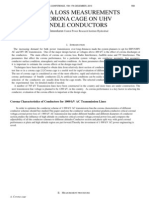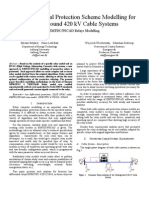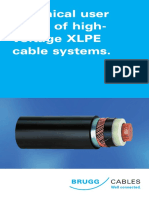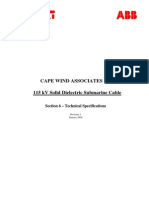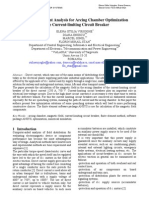Conductor Technologies in Transmission Networks Executive Summary
Conductor Technologies in Transmission Networks Executive Summary
Uploaded by
Kunal RajaCopyright:
Available Formats
Conductor Technologies in Transmission Networks Executive Summary
Conductor Technologies in Transmission Networks Executive Summary
Uploaded by
Kunal RajaOriginal Title
Copyright
Available Formats
Share this document
Did you find this document useful?
Is this content inappropriate?
Copyright:
Available Formats
Conductor Technologies in Transmission Networks Executive Summary
Conductor Technologies in Transmission Networks Executive Summary
Uploaded by
Kunal RajaCopyright:
Available Formats
WG B5.
23
technical brochure 587
Short Circuit Protection of Circuits with Mixed
Conductor Technologies in Transmission
Networks Executive Summary
Members
Luc Uyttersprot, Convenor (BE), José Manuel Roca, Secretary (ES), André dos Santos (PT),
Demetrios Tziouvaras (USA), Jens Eilart (DE), John Kemmlert (SE), Laurent Dormès (FR),
Peter Rønne-Hansen (DK), Simon Chano (CA)
Corresponding Member
Richard Prins (AU)
Introduction amongst the members of the Working Group. Several topics
were addressed – use of mixed conductor circuits, use of the
At transmission level, most circuits are overhead lines but we auto-reclosing on them and its blocking in case of a fault in the
also find underground cables and, in a much less extent, Gas cable section. A large part of the brochure is dedicated to the
Insulated Lines. Until recently, most underground cable circuits modelling of such mixed conductor circuits, based on widely
were used in cities or for special applications but nowadays, accepted models. The models have been extended to be able to
environmental constraints favour the use of underground calculate all currents, voltages in the case of an internal fault in
cable. One consequence of this is the increasing use of circuits the underground cable, taking into account sheath earthing .
composed of several sections of overhead line and underground The results presented in the TB are computed with simple and
cable. The objective of this brochure is to analyse the impact readily available mathematical tools. The goal is to give the reader
of the association of an overhead line with an underground the opportunity to adapt the models to its specific needs. Based
cable in the same circuit on the protection system and on the on the modelling of the mixed conductor circuits, proposals are
auto-reclose scheme associated with the circuit. made for their protection and for fault discrimination between
the different sections. We find also more practice – oriented
From a protection point of view, a mixed conductor circuit chapters for the engineering of the transition between overhead
is characterized by the fact that the value and/or the behaviour line and underground cable sections and for the testing of these
of the impedance as a function of the length differs significantly installations. One of the Preferential Subjects of the Colloquium
between sections. In the case of a mixed conductor circuit with organized in 2011 in Lausanne by SC B5 was dedicated to the
overhead line and underground cable sections, both effects are protection of that kind of circuits and several new trends have
present:. Consequently, the use of impedance based protection been presented. Most of them are related to the question : how
for mixed conductor circuits requires more attention, compared can we avoid the need for power supply and equipment at the
to a traditional homogenous and linear overhead line. transition and still be able to discriminate between a fault in the
cable and one in the line?. Many of the answers are integrated
From an operational point of view, a mixed conductor in the TB.
circuit can give rise to conflicting auto-reclose philosophies. On
overhead lines, auto-reclosing is very often applied because of Description of the TB
the non-permanent characteristic of the majority of faults. On
the contrary, as most underground cable faults are permanent, First chapter is a general introduction. It deals with the
there is no auto-reclose function for underground cable circuits. applications of mixed conductor circuits, followed by a
The question arises now: what shall we do in case of a mixed description of most commonly used circuit configurations –
conductor circuit? The answer to this question is beyond the two-ends, three-ends, underground cable section at one end,
scope of this brochure but we will give methods to discriminate underground cable section between two overhead lines, multiple
between a fault in the overhead line section and one in the underground cable sections. After this, we find an introduction to
underground cable section in order to block the autoreclose the protection and other aspects of the mixed conductor circuits,
when a fault in the underground cable section occurs. a short description of the policy and applications of those
circuits in several countries. The results of the questionnaire are
Scope/Methodology finally analysed.
The brochure starts with a questionnaire distributed Second chapter describes all relevant electrical charac-•••
No. 275 - August 2014 ELECTRA 75
WG B5.23
technical brochure 587
Figure 1 - impedance for an internal fault seen by one end of the circuit
teristics of underground cables. We find a description of the and the shunt sequence admittance matrix for overhead lines
different types of High Voltage underground cables – paper is explained. We continue with the underground cables. In this
insulated cables(high pressure fluid filled pipe cables, self case, the current ground return path is evaluated based on the
contained fluid filled cables), polymeric cables -, of the accessories work of Pollaczek. Series impedance and shunt admittance
– joints, terminals -, of the metallic sheath of the cable including matrices computation is explained, followed by the computation
bonding techniques – solid bonding, single point bonding, of the series sequence impedances for different bonding
cross-bonding – and the associated Surge Voltage Limiter, of techniques. For each case an example is computed according to
cable arrangement – flat, trefoil, ...- and of laying techniques. the method described and a comparison with EMTP is given.
The material for this part of chapter 2 is mainly extracted from A comparison between measured and calculated values for a
existing CIGRE TB. Second part of chapter 2 is dedicated to the 150 kV underground cable circuit is also included. Next section
comparison of service experience and faults statistics between adresses the computation of the impedance seen from the ends
overhead lines and underground cables based on CIGRE and of the circuit in case of an internal fault in the underground cable
EntsoE Nordic published data. This is an important input for for different bonding techniques. The result of this computation
the selection of an appropriate auto-reclose policy. for the case of 1 major section and 3 minor sections without
earth continuity conductor is given in figure 1. Finally, this
Third chapter deals with circuit modelling – overhead computation is extended to the case of a mixed conductor circuit
lines, underground cables, mixed conductor circuits – and the for different bonding techniques and circuit configurations.
computation of the impedance in case of an internal fault. It
starts with a section on the earth resistivity and its impact on Fourth chapter deals with the protection scheme design
circuit impedance . It is followed by the overhead line electrical and selection for mixed conductor circuits. The description
characteristics calculation . The current ground return path is of the general requirements for protections – dependability,
evaluated from Carson work. Based on these characteristics, the security, speed, sensitivity and selectivity – is followed by current
method to determine the series sequence impedance matrix transformer’s requirements description. Next section deals •••
Figure 2 - Auto-reclose blocking principle
No. 275 - August 2014 ELECTRA 77
WG B5.23
technical brochure 587
Figure 3 - auxiliary power supply from wind turbine and photovoltaic panels
with the application of protections with relative selectivity, Conclusion and main follow up
namely the distance protection. Examples of discrimination
between fault on the underground cable section and fault on the The TB gives all informations to compute series impedances,
overhead line section based on distance protection are given for shunt admittances and sequence series impedances for overhead
different configurations of mixed conductor circuits. Protection lines, underground cables and mixed conductor circuits. It also
schemes based on protections with absolute selectivity – current covers impedance calculation for internal faults in underground
differential protections, phase comparison protections, negative cables. Protection schemes to discriminate between faults in
sequence directional comparison schemes - are then described. the underground cable section and faults in the overhead line
Finally, detailed applications from several countries are section, with and without relays installed at the transition, are
explained. One of these applications showing the auto-reclose described. Several solutions for transition equipments auxiliary
blocking principle is shown in figure 2. supply are described and compared. Finally, emerging solutions
allowing a precise fault discrimination between sections
Chapter 5 deals with transition requirements . Auxiliary avoiding the need for transition equipment are presented.
supply is an important topic. Computation of the loads and
possible solutions for the auxiliary source are described along
with an economical comparison. Input sources for the relays and
environmental factors are relevant issues as well. An example of
auxiliary power supply from wind turbine and photovoltaic
panels is shown in figure 3. BROCHURE N° 587
Chapter 6 deals with the testing of mixed conductor circuits. (en anglais seulement)
Finally, chapter 7 deals with new trends. The main goal of these (in English only)
is to simplify the protection scheme and to avoid the installation
of relays at the transition. A first trend includes optical current En vente au Bureau Central (PDF)
transformers installed at the transition but directly connected On sale at the Central Office
via an optical fibre to a differential protection at one end of the
circuit. A second trend uses a Fibre Bragg Grating to measure the
current at several locations alongside the circuit with the same Prix non-Membres
optical fibre. Another trend is based on distance protections with
an enhanced measurement accuracy in order to compensate Non-Member Price:
the impact of the load transfer. The use of a synchrophasor 460 e
based fault location algorithm is another possibility. A table
summarizes the status of each trend – industrial use or not -, its http://www.e-cigre.org
impact on the the transition design, the kind of faults detected, Purchase (non-members)
the application and the quality of the fault discrimination or download (members)
between cable and line sections.
No. 275 - August 2014 ELECTRA 79
You might also like
- Chap DC Gen SolDocument17 pagesChap DC Gen SolZain Ul Abideen Afridi83% (6)
- Application of Matrix Methods To The Solution of Travelling-Wave Phenomena in Polyphase SystemsDocument13 pagesApplication of Matrix Methods To The Solution of Travelling-Wave Phenomena in Polyphase SystemsKunal RajaNo ratings yet
- Bumper Car ManualDocument52 pagesBumper Car ManualHaris Kolasinac100% (1)
- Impedance and Admittance Calculations of A Three-Core Power Cable by The Finite Element MethodDocument9 pagesImpedance and Admittance Calculations of A Three-Core Power Cable by The Finite Element MethodRadhaNo ratings yet
- 220kV-400Kv-345KV Details of CableDocument26 pages220kV-400Kv-345KV Details of CableDhanaji Wakade100% (1)
- Lightning Performance of Cmpact Lines PDFDocument20 pagesLightning Performance of Cmpact Lines PDFABRAHAMNo ratings yet
- k1 FCL DigSilentDocument8 pagesk1 FCL DigSilentksg9731No ratings yet
- Models - Acdc.submarine Cable 01 IntroductionDocument64 pagesModels - Acdc.submarine Cable 01 Introductionisai.diaz2995No ratings yet
- CIRED 2 - MatheusDocument4 pagesCIRED 2 - MatheusEstácio Tavares Wanderley NetoNo ratings yet
- Electrical Parameters of Low-Voltage Power Distribution Cables Used For Power-Line CommunicationsDocument8 pagesElectrical Parameters of Low-Voltage Power Distribution Cables Used For Power-Line Communicationsmt6760No ratings yet
- Calculated Short Circuit BehaviourDocument5 pagesCalculated Short Circuit Behaviourramlijavier0% (1)
- Crosstalk Analysis in Complex Aeronautical Bundle: Charles Jullien, Philippe Besnier Michel Dunand Isabelle JunquaDocument6 pagesCrosstalk Analysis in Complex Aeronautical Bundle: Charles Jullien, Philippe Besnier Michel Dunand Isabelle JunquaEngineerOmarNo ratings yet
- Universidad Tecnólogica de Panamá: 1. Commissioning Practical Aspects of Relays With IECDocument20 pagesUniversidad Tecnólogica de Panamá: 1. Commissioning Practical Aspects of Relays With IECIsaac JustinNo ratings yet
- Engineering Failure Analysis: Bora Alboyaci, Mehmet Aytac CINAR, Yunus Berat DEMIROL, Adem INCEDocument15 pagesEngineering Failure Analysis: Bora Alboyaci, Mehmet Aytac CINAR, Yunus Berat DEMIROL, Adem INCELuiz KowalskiNo ratings yet
- Research 2Document8 pagesResearch 2SYED HAMZA ALINo ratings yet
- A Practical Approach of Reducing Dielectric Losses and Calculation of An Existing 33KV HV-UG Power Cable of A Distribution NetworkDocument17 pagesA Practical Approach of Reducing Dielectric Losses and Calculation of An Existing 33KV HV-UG Power Cable of A Distribution NetworkudayakumartNo ratings yet
- Power Transmission Over Long Distances With CablesDocument8 pagesPower Transmission Over Long Distances With CablesramsesiNo ratings yet
- Current Distribution and Losses of Grouped Underground CablesDocument9 pagesCurrent Distribution and Losses of Grouped Underground CablesmanojNo ratings yet
- Scheme For Accelerated Trip For Faults in The SecoDocument3 pagesScheme For Accelerated Trip For Faults in The SecoSALAH SALLAMNo ratings yet
- Lab - 01Document7 pagesLab - 01Shahid ButtNo ratings yet
- Points To Consider Regarding The Insulation Coordination of GIS Substations With Cable Connections To Overhead LinesDocument5 pagesPoints To Consider Regarding The Insulation Coordination of GIS Substations With Cable Connections To Overhead Linesmoh_essamoNo ratings yet
- Electrostatic Stress Analysis of High Voltage CablesDocument4 pagesElectrostatic Stress Analysis of High Voltage CablesesatjournalsNo ratings yet
- Thesis Electrical Power DistributionDocument6 pagesThesis Electrical Power DistributionWritingServicesForCollegePapersNewHaven100% (2)
- Underground Cable Fault Detection and Alert: Sujay S, R Monisha, Prathibha Rekha MurthyDocument6 pagesUnderground Cable Fault Detection and Alert: Sujay S, R Monisha, Prathibha Rekha MurthyShankar gowdaNo ratings yet
- Transmission Line Transposition: December 2009Document5 pagesTransmission Line Transposition: December 2009Danillo AugustoNo ratings yet
- Zulfaqar: Journal of Defence Science, Engineering & TechnologyDocument15 pagesZulfaqar: Journal of Defence Science, Engineering & TechnologyOlga OliveiraNo ratings yet
- Cables Theory DesignDocument25 pagesCables Theory DesignA. HassanNo ratings yet
- 1097RDocument7 pages1097ReddisonfhNo ratings yet
- Circulating Current FGDocument10 pagesCirculating Current FGMadhusudhan SrinivasanNo ratings yet
- The Use of Underbuilt Wires To Improve TDocument9 pagesThe Use of Underbuilt Wires To Improve TTâm Nguyễn ThànhNo ratings yet
- Artigo LinhasDocument8 pagesArtigo LinhasludokellypNo ratings yet
- Cable Ampacity Calculation and Analysis For Power Flow OptimizationDocument6 pagesCable Ampacity Calculation and Analysis For Power Flow OptimizationRiyadh ZakiNo ratings yet
- 2007 Korea Vasconcelos2Document7 pages2007 Korea Vasconcelos2Hamza RossafiNo ratings yet
- A Lumped Winding Model For Use in Transformer Models For Circuit SimulationDocument16 pagesA Lumped Winding Model For Use in Transformer Models For Circuit SimulationLucio BianchiNo ratings yet
- Synthesis of Lumped Transmission-Line AnalogsDocument13 pagesSynthesis of Lumped Transmission-Line AnalogsIulius LucaNo ratings yet
- 10.1515 - Eng 2022 0004Document9 pages10.1515 - Eng 2022 0004Abhishek ReddyNo ratings yet
- Series Impedance of Distribution Cables With Sector-Shaped ConductorsDocument8 pagesSeries Impedance of Distribution Cables With Sector-Shaped Conductorstees220510No ratings yet
- Polarisation Mechanisms and Their Effect in Cable Joints: T Joubert, J.J. WalkerDocument4 pagesPolarisation Mechanisms and Their Effect in Cable Joints: T Joubert, J.J. WalkersajuaanalsaNo ratings yet
- Cable Sheath Loss Reduction Strategy Research Based On The Coupled Line ModelDocument9 pagesCable Sheath Loss Reduction Strategy Research Based On The Coupled Line ModeleduardoNo ratings yet
- Disconnectors Reliability On The French Grid and Means To Reduce The Consequences of Their FailuresDocument7 pagesDisconnectors Reliability On The French Grid and Means To Reduce The Consequences of Their Failureskushwah9kpriyaNo ratings yet
- Seminar 2Document9 pagesSeminar 2mohdaskar22No ratings yet
- Euseofflux2D Euseofflux2D Euseofflux2D Euseofflux2D: 1. Defects For Electric Power TransformersDocument6 pagesEuseofflux2D Euseofflux2D Euseofflux2D Euseofflux2D: 1. Defects For Electric Power TransformersConstantin DorinelNo ratings yet
- Cables (HT<) : Energy Estimation & Audit (15ee430)Document73 pagesCables (HT<) : Energy Estimation & Audit (15ee430)rohith mukkamalaNo ratings yet
- An Investigation of The Performance of Underground Cable Installations in Operational and Fault ConditionsDocument7 pagesAn Investigation of The Performance of Underground Cable Installations in Operational and Fault Conditionsengmostafa darwishNo ratings yet
- 16th National Power Systems ConferenceDocument11 pages16th National Power Systems ConferenceHarish ReddyNo ratings yet
- Cable PDFDocument8 pagesCable PDFmufa tsanNo ratings yet
- Online Power Trfo AnalysisDocument6 pagesOnline Power Trfo AnalysisCaio FlemingNo ratings yet
- Lightning Performance of 500-kV Double-Circuit Line Schemes For The Three-Gorge ProjectDocument8 pagesLightning Performance of 500-kV Double-Circuit Line Schemes For The Three-Gorge ProjectAlcides NetoNo ratings yet
- Configuration Optimization of Underground Cables For Best AmpacityDocument9 pagesConfiguration Optimization of Underground Cables For Best Ampacitylen.kyokuNo ratings yet
- Automatic Circuit Breaker ACB For Low Voltage SubsDocument23 pagesAutomatic Circuit Breaker ACB For Low Voltage Subsallan kiplimoNo ratings yet
- Nanometer MOSFETDocument12 pagesNanometer MOSFETSibi ManojNo ratings yet
- Line Differential Protection Scheme Modelling (PDF Library)Document6 pagesLine Differential Protection Scheme Modelling (PDF Library)Nirmal RajaNo ratings yet
- Numerical Simulation of Electric FieldDocument6 pagesNumerical Simulation of Electric FieldMagdi SaadawiNo ratings yet
- Technical User Guide HV XLPE Cable Systems enDocument21 pagesTechnical User Guide HV XLPE Cable Systems enTaner ErtürkNo ratings yet
- Firelli Submarine ProposalDocument23 pagesFirelli Submarine ProposalAct PornlapusNo ratings yet
- 3d AnalysisDocument10 pages3d AnalysisShobhaNo ratings yet
- Substations - Volume V - CircuitDocument44 pagesSubstations - Volume V - CircuitAbdul Wadood GharsheenNo ratings yet
- Antyenna DesignDocument4 pagesAntyenna DesignJINEETH JJOSEPHNo ratings yet
- It Is Quite Another Electricity: Transmitting by One Wire and Without GroundingFrom EverandIt Is Quite Another Electricity: Transmitting by One Wire and Without GroundingNo ratings yet
- Distribution of Electrical Power: Lecture Notes of Distribution of Electric Power CourseFrom EverandDistribution of Electrical Power: Lecture Notes of Distribution of Electric Power CourseNo ratings yet
- Distribution of Electrical Power: Lecture Notes of Distribution of Electrical Power CourseFrom EverandDistribution of Electrical Power: Lecture Notes of Distribution of Electrical Power CourseNo ratings yet
- 4 SiC SchottkyParameter Extraction Procedure - Ruiyun FuDocument24 pages4 SiC SchottkyParameter Extraction Procedure - Ruiyun FuKunal RajaNo ratings yet
- 2 WBG Device CharacteristicsDocument86 pages2 WBG Device CharacteristicsKunal RajaNo ratings yet
- An Alternative To IEEE 802.11ba: Wake-Up Radio With Legacy IEEE 802.11 TransmittersDocument19 pagesAn Alternative To IEEE 802.11ba: Wake-Up Radio With Legacy IEEE 802.11 TransmittersKunal RajaNo ratings yet
- 1 IntroductionLectureDocument99 pages1 IntroductionLectureKunal RajaNo ratings yet
- Lecture 1: Power Systems Overview: Prof. Tom Overbye Dept. of Electrical and Computer Engineering Texas A&M UniversityDocument52 pagesLecture 1: Power Systems Overview: Prof. Tom Overbye Dept. of Electrical and Computer Engineering Texas A&M UniversityKunal RajaNo ratings yet
- 28 Lossy Transmittion Lines, Dispersion, and Group VelocityDocument12 pages28 Lossy Transmittion Lines, Dispersion, and Group VelocityKunal RajaNo ratings yet
- Performance Analysis of Inverter Based Maximum Power Point Tracking For PV Grid-Connected SystemDocument5 pagesPerformance Analysis of Inverter Based Maximum Power Point Tracking For PV Grid-Connected SystemHari ReddyNo ratings yet
- Pornirea MS Cu Magnet PermanentDocument6 pagesPornirea MS Cu Magnet PermanentMeterna AdrianNo ratings yet
- Power House 1Document2 pagesPower House 1Muhammad IshfaqNo ratings yet
- Experiment 16 Troubleshooting A CE AmplifierDocument12 pagesExperiment 16 Troubleshooting A CE AmplifierJeremy Porillo100% (1)
- Catelog-Ilin 2022Document133 pagesCatelog-Ilin 2022Tan Wei GhuanNo ratings yet
- Electrode CalculationDocument2 pagesElectrode CalculationRanjan Kumar100% (2)
- Active and Passive ComponentsDocument2 pagesActive and Passive Componentssarsm56No ratings yet
- Rubycon (Radial Thru-Hole) YXG SeriesDocument3 pagesRubycon (Radial Thru-Hole) YXG SeriesOndrej LomjanskiNo ratings yet
- Pedrollo Centrifugalne Pumpe PDFDocument28 pagesPedrollo Centrifugalne Pumpe PDFzare250% (1)
- Motor Current SignatureDocument5 pagesMotor Current Signaturel1f3b00kNo ratings yet
- 4N35 OptocouplersDocument7 pages4N35 OptocouplersattapapaNo ratings yet
- Valkyrie As: Addressable Wall Mount Sounder/ BeaconDocument1 pageValkyrie As: Addressable Wall Mount Sounder/ BeaconMihai Butnaru-PaladeNo ratings yet
- How To Configure A 555 Timer ICijDocument2 pagesHow To Configure A 555 Timer ICijJose C. Lita JrNo ratings yet
- SPF-55139 c1Document27 pagesSPF-55139 c1haythem.boughzalaNo ratings yet
- General Description Features: 380Khz, 18V/2A Synchronous Step-Down DC-DC ConverterDocument19 pagesGeneral Description Features: 380Khz, 18V/2A Synchronous Step-Down DC-DC Converteroscar1162001No ratings yet
- Catalogo Equipo Aire Acondicionado Portatil TGMDocument1 pageCatalogo Equipo Aire Acondicionado Portatil TGMSolucionesenfrio saNo ratings yet
- Magnetization and Demagnetization of Ferromagnetic MaterialsDocument5 pagesMagnetization and Demagnetization of Ferromagnetic MaterialsHares SlalNo ratings yet
- Niraj K. Jha, Sandip Kundu (Auth.) Testing and Reliable Design of CMOS Circuits 1990Document238 pagesNiraj K. Jha, Sandip Kundu (Auth.) Testing and Reliable Design of CMOS Circuits 1990jjnNo ratings yet
- Commissioning of Electrical EquipmentDocument3 pagesCommissioning of Electrical EquipmentThomas RussellNo ratings yet
- 2nd Training SessionDocument37 pages2nd Training SessionHimanshu SharmaNo ratings yet
- Strain Dependent Electronic Structure and Optical Properties Tuning of InN/ PtX2 (X S, Se) Van Der Waals HeterostructuresDocument8 pagesStrain Dependent Electronic Structure and Optical Properties Tuning of InN/ PtX2 (X S, Se) Van Der Waals HeterostructuresNguyen ChuongNo ratings yet
- Solar Tracking and Positioning Robot For PV SystemsDocument1 pageSolar Tracking and Positioning Robot For PV Systemslaithismail200018No ratings yet
- Fault Codes - Multi & CACDocument19 pagesFault Codes - Multi & CACGabriel Marian BechmanNo ratings yet
- Exploded View Parts List (UE40F5370SSXZG) PDFDocument11 pagesExploded View Parts List (UE40F5370SSXZG) PDFgeorgedragosNo ratings yet
- 3 Phase Motor ConstructionDocument21 pages3 Phase Motor ConstructionAurelio Jr TambigaNo ratings yet
- MAM6090Document43 pagesMAM6090MITHULA MITHRA MMNo ratings yet
- Series: 800W DC Power SuppliesDocument6 pagesSeries: 800W DC Power Suppliesneparun16No ratings yet
- Scientific Research ClassDocument72 pagesScientific Research ClassEman LaloNo ratings yet












































